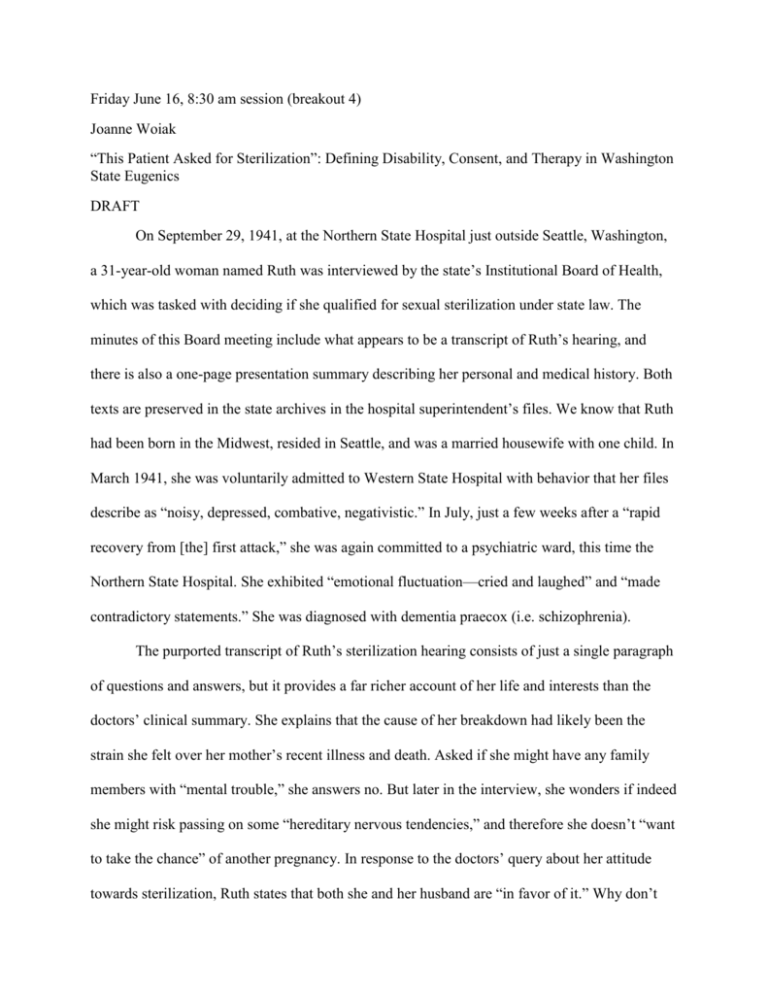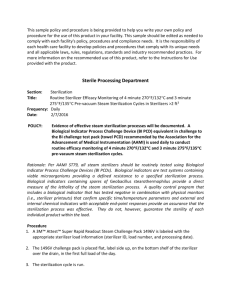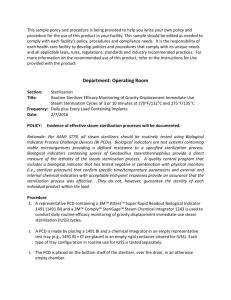Friday June 16, 8:30 am session (breakout 4) Joanne Woiak “This
advertisement

Friday June 16, 8:30 am session (breakout 4) Joanne Woiak “This Patient Asked for Sterilization”: Defining Disability, Consent, and Therapy in Washington State Eugenics DRAFT On September 29, 1941, at the Northern State Hospital just outside Seattle, Washington, a 31-year-old woman named Ruth was interviewed by the state’s Institutional Board of Health, which was tasked with deciding if she qualified for sexual sterilization under state law. The minutes of this Board meeting include what appears to be a transcript of Ruth’s hearing, and there is also a one-page presentation summary describing her personal and medical history. Both texts are preserved in the state archives in the hospital superintendent’s files. We know that Ruth had been born in the Midwest, resided in Seattle, and was a married housewife with one child. In March 1941, she was voluntarily admitted to Western State Hospital with behavior that her files describe as “noisy, depressed, combative, negativistic.” In July, just a few weeks after a “rapid recovery from [the] first attack,” she was again committed to a psychiatric ward, this time the Northern State Hospital. She exhibited “emotional fluctuation—cried and laughed” and “made contradictory statements.” She was diagnosed with dementia praecox (i.e. schizophrenia). The purported transcript of Ruth’s sterilization hearing consists of just a single paragraph of questions and answers, but it provides a far richer account of her life and interests than the doctors’ clinical summary. She explains that the cause of her breakdown had likely been the strain she felt over her mother’s recent illness and death. Asked if she might have any family members with “mental trouble,” she answers no. But later in the interview, she wonders if indeed she might risk passing on some “hereditary nervous tendencies,” and therefore she doesn’t “want to take the chance” of another pregnancy. In response to the doctors’ query about her attitude towards sterilization, Ruth states that both she and her husband are “in favor of it.” Why don’t 2 they want to have any more children? Ordinary family planning considerations, she explains: their daughter is already 12 years old and there would be too large a gap in ages if they had another child. The members of the Board voted 4-1 in favor of sterilizing her. But the doctors’ opinions were mixed as to whether rendering her infertile was necessary for the eugenic good of society, or for the therapeutic benefit of the patient herself. The transcript is prefaced by the succinct comment: “This patient asked for sterilization.” This patient asked for sterilization. What did this sentence mean to Ruth, her family, the physicians at Northern State Hospital, and the superintendents on the Institutional Board of Health? Why was this sentence included at all in the record of the Board’s business—why was it deemed important to present this individual as a person with a disability who was a willing participant in state-sanctioned eugenics? Should this document—and the process of the hearing—be interpreted as merely the “illusion of consent,” or can we imagine that there was some meaningful choice involved? Or both? This is the only document of its kind that I have found so far in my archival research on the Washington state sterilization program. Its brief narratives reveal clues about the lives of nine of the 685 documented victims of the compulsory sterilization law. In this paper, I focus on excavating the possible meanings of this sentence, in the light of other kinds of materials that I’ve found about Washington’s history of forced sterilization, as well as scholarship based on sterilization records from other states. The surviving records about the implementation of the Washington law are fragmentary. It’s been a challenge to work with the state archivists to be able to locate and utilize materials pertaining to patient medical histories from the 1930s and 40s, and I still need to do a lot more digging. Nonetheless, I think it’s possible to begin using the available information not only to construct an account of this neglected aspect of local history, but also to demonstrate the contributions that a disability studies perspective can make to the historiography of eugenics. 3 These records provide a window into interpreting the various and even conflicting meanings of sterilization for the individuals involved—especially in terms of history from the patient’s perspective. An analysis of individual cases is also important for informing wider questions about the history and legacy of public policies and medical practices, and the ways that these make meanings out of human differences. This patient asked for sterilization. Read through the lens of mainstream understandings of eugenics, the sentence makes little sense. As eugenics historian Molly Ladd-Taylor puts it, the American history of compulsory sterilization is generally remembered and depicted as a “Nazilike scandal.” On this view, eugenics was mainly about antiquated biases against racial groups deemed biologically inferior; about involuntary state-sponsored measures for preventing procreation; and about sacrificing individual rights and well-being to the greater public good. This fairly narrow interpretation of the eugenics movement has been revised by recent historiography illustrating just how popular and heterogeneous the organized eugenics movement actually was. Eugenics ideology and practices were flexible enough to advance a wide variety of social interests. Eugenics was always more complicated and diversified than just the history of sterilization laws, and as I hope to show here, compulsory sterilization itself was more complex and ambiguous than what we know from the mainstream narratives. This patient asked for sterilization. The statement implies that somehow eugenics could have been perceived as bestowing some personal benefit on its victims, and that they were free to make this reproductive choice. A number of historians have begun addressing the rhetoric of therapeutic value and the appearance of patient agency in sterilization records in certain states (North Carolina / Johanna Schoen, Oregon / Phil Ferguson, California / Alexandra Stern, Minnesota / Molly Ladd-Taylor). They have shown that doctors sometimes argued that sexual surgery would “cure” men of violent or deviant tendencies and “protect” women from the 4 psychological perils of pregnancy, that families of people with intellectual disabilities might have agreed to have the sterilization procedure done in order to secure their release from institutions, and that in a few cases women may even have petitioned the authorities for their own eugenic sterilization because they lacked any other reliable form of birth control. While these scholars have vastly enriched our understandings of the methods and motives for deploying sterilization legislation in specific locales, I contend that they have still not adequately addressed one key question—who counted as a “patient”? Disability studies provides the critical tools needed to fully explore this aspect of the sterilization movement. Talking explicitly about the question “what was disability” raises new possibilities for understanding WHO was targeted for institutionalization and sterilization, HOW sterilization decisions were made, and WHY sexual surgery was recognized as an appropriate solution to social problems. The state of Washington has always been on the “cutting edge” of advances in medical interventions, biotechnologies, and laws that impact people with disabilities and other marginalized groups. In 1909, we passed the second forced sterilization statute in the world. It was a punitive measure directed at people labeled as habitual criminals or convicted of the crimes or rape or child molestation. That law withstood a high court challenge and remains on the books to this day, although evidently it has always been a dead letter. Washington was again in the national forefront in 1921, when we ratified a second law that more broadly targeted people with disabilities and included a formal appeals process, in response to the first wave of constitutional challenges to forced sterilization. In the modern era, Washington continues to operate several state institutions for people with mental disabilities, long after other states have closed theirs, and our status as a medical and biotech center is seen as congruent with controversial developments such as the Ashley X treatment and a physician assisted suicide law. The history of eugenics and sterilization ought to be included in conversations about all of these 5 disability rights and policy issues, yet little work has so far been done to uncover and interpret our past and its legacies. Under Washington’s 1921 sterilization statute, superintendents of the state hospitals and custodial schools for individuals labeled with mental disabilities were directed to “report all feebleminded, insane, epileptic, habitual criminals, moral degenerates and sexual perverts, who are persons potential to producing offspring, who because of inheritance of inferior or anti-social traits, would probably become a social menace or wards of the state.” The statute required that patients or their guardians be informed of the sterilization order and that they had 15 days to appeal. Also notable is that Washington’s 1921 law specified two legitimate purposes for involuntarily sterilizing someone: eugenic and therapeutic. “For the betterment of the physical, mental, neural, or psychic condition of the inmate, or to protect society from the menace of procreation by said inmate.” The Institutional Board of Health was expected to meet 2 or 3 times per year at each of the five state facilities, where as many as 50 inmates would be presented per hearing. In the state archives, I have found documents from 12 of these meetings over a 6 year span, as well as correspondence between superintendents and state officials regarding the Board’s activities and legal duties. According to the official tallies, a total of 403 “insane” people and 276 “mentally deficient” people were legally sterilized, most between 1936 and 1942, when the state Supreme Court overturned the law. 73% of the total number of victims were women, while a remarkable 88% of the so-called “feebleminded” cases were women. The files that I have located provide limited information about 170 individuals at the mental hospitals and custodial schools who were presented and either rejected for sterilization or whose fates were not recorded. The most substantial and complete patient information comes from another 95 cases at Northern State Hospital. All of the sterilization candidates are described as being of the “white race,” most as 6 “Protestant,” and almost all as having an economic status of either “marginal” or “dependent.” The youngest was a 15 year old woman, the oldest a 47 year old man. For each of those 95 patients, the Board generated 12 pages of standardized forms used to provide legal notification of the order and to request that the patient and a family member indicate their consent for the operation. 75% of the time the Board voted to approve sterilization and, according to handwritten notes at the top of 70 of those forms, the operation soon followed. In only a few cases were the consent forms not signed, and sometimes those individuals were sterilized anyway. Who qualified for sterilization? Most scholarship on eugenics in the US challenges the eugenicists’ prejudiced ideas about biological inferiority regarding racial differences, gender roles, class status, or sexuality, while implying that there was a distinct set of victims who were actually “suffering” from mental disabilities. These historians thus take disability for granted as a natural and objective condition. The “truly” disabled patients and inmates may be presumed to be the “deserving” objects of eugenicists’ attention, and certainly would not be considered capable of making their own reproductive choices. The story of Ruth, the patient at Northern State Hospital who “asked for sterilization,” illustrates the value of integrating the vantage point of disability studies into the interpretation of these patient records. Ruth was described as white, economically “comfortable,” and seemingly a successful wife and mother. Some readers might therefore identify her as one of the “truly disabled,” suffering from depression and hallucinations, as her medical files indicated. But her own statement to the Board contextualizes her own experience of disability—she experienced a traumatic event (her mother’s death) that she thinks precipitated her breakdown. When the doctors committed her to Northern and voted to sterilize her, they framed her psychological distress more simplistically as hereditary insanity. They created disability as a fixed biological trait. 7 The surviving documents from the Board meetings at Northern State Hospital reveal the ways that traumatic experiences and deviance from social norms could be readily translated into medical diagnoses. In particular, what was labeled as mental disease and disability was often determined by normative assumptions around class, sexuality, and gender. My point is not that these people were “misdiagnosed,” but rather that the category of disability was defined and delineated in extremely broad fashion, thereby serving the interests of reinforcing professional expertise and social control of problem groups and individuals. A few examples from Northern: Genevieve, diagnosis manic depressive, precipitated by pregnancies; 26 year old housewife with two children, husband’s whereabouts unknown; has a “sensitive disposition” and is “frigid sexually;” “had two children and each time had a mental attack;” has suicidal tendencies and requires restraint. Olga, psychosis with mental deficiency; 18 years old and in the hospital for 8 months; her mother was also a patient; nervous since birth, excited over trifles, irritable, disagreeable, and ugly; “thought her brother and other relatives were having sexual relations with her, showed memory defects and impairment of judgment.” Marcene, psychosis with mental deficiency; 16 years old and IQ of 65; parents are from Sweden and both have mental illness; failed at vocational schools, arrested for vagrancy, quarrelsome, obscene, and promiscuous sexually. Lois, manic depressive; 25 years old, mother and brother have been patients; left high school because of a pregnancy; husband was alcoholic and abusive; upon divorce, her two younger children were given up for adoption; “became erratic and quarrelsome, threatening, flighty, emotional.” Walter, dementia praecox, paranoid type; 22 years old, has been in the hospital 11 months; discharged from the Army due to disability, never had an occupation, is unemployed. John, schizophrenic and homosexual; 27 years old, and family supports him financially; has admitted “acts of perversion” since age 16; committed petty 8 larceny;is “dull and seclusive, no initiative, has auditory hallucinations;” has shown no change since receiving metrazol shock therapy. A few patterns emerge from these stories of psychological distress and social nonconformity: women and men who were struggling financially; women who did not fit society’s standards for femininity (i.e. they were not chaste girls, happy wives, and good mothers); men who did not fit society’s standards for masculinity (i.e. they were not strictly heterosexual and self-sufficient); women who were experiencing some kind of post-partum depression, stress in their home lives, or even domestic violence; people with criminal histories; and people whose families were recent immigrants. I think it’s important not to generalize too broadly from these documents about the meanings of disability, gender, class, ethnicity, and the intersections between them. But reading between the diagnostic lines we can learn a bit about the experiences that likely brought these inmates to the Board’s attention in the social context of the late 1930s. The few records I’ve found from the state custodial schools similarly suggest that sexuality, gender roles, and economic dependency were main determinants of candidacy for sterilization among people labeled with intellectual disabilities. In some cases, so-called mentally deficient men were operated on and then paroled from the institution when their families reported that a job was waiting for them at home. One set of forms from a 1940 Board meeting emphasized the problem of sexual deviance in both the male and female inmates. Of the six women, four were labeled “feebleminded of moron classification” with tendency to be “sexually promiscuous” or “heterosexual.” The descriptions of the seven men included: “some homosexual tendencies,” “stepmother complained of sexual advances,” “has molested small girls,” and “homosexual tendencies and masturbation.” Of the 13 inmates presented that day, the Board ordered that 11 of them be sterilized for “eugenic benefit,” and that one be sterilized for her own “personal benefit.” Attaching a biomedical interpretation to undesirable deviancies from social 9 norms justified the solution of sterilizing of people deemed “moral degenerates and sexual perverts” under the law. Previous scholarship has shown how the category “feeblemindedness” exploded in size and social significance after the turn of the century, in response to anxieties among elites about citizenship, immigration, economic crisis, and shifting gender roles. There has also been substantial analysis of reproductive politics in the eugenics era, focusing on the intersections between gender, class, and race. [Kline, Ladd-Taylor, Kluchin] Even though these scholars are writing about “feeblemindedness,” critical analysis of the disability dimension of this history is generally lacking. [Rembis, Carlson, Stubblefield, Carey] Recognizing the ableist attitudes that underlay policies of sterilization and institutionalization can greatly enrich the critiques already developed from a gender studies perspective. In particular, from the vantage point of disability as a form of diversity, we can recognize that what the eugenicists’ biomedical approach framed as traits of “incompetence” and “immorality” are better understood in terms of a disabling society that did not provide people with impairments with supports or skills training they needed in areas such as sex education, parenting, and independent living. Feminist writers have noted that the public today is still generally unsympathetic towards demands for reproductive rights when these are made by women who are poor or on welfare (welfare queens, etc.). When reproductive politics are also viewed through a disability lens, we can see even harsher skepticism about the rights and capacities of people with disabilities to have and support families of their own. What can a disability lens tell us about the decision making processes under Washington’s sterilization law? Evidence from the archival records, such as Ruth’s case in which she allegedly wanted a contraceptive sterilization, suggest not just a blurring of the lines between consent and coercion, but significant differences in what consent meant for different stakeholders. If eugenics was about compulsory reproductive control, then how could inmates 10 have volunteered for the sterilization procedure? If the Washington law did not require consent, then why did the superintendents who implemented it insist that consent forms be signed by the patient or guardian? And if people were committed to mental hospitals and custodial schools because they were deemed “mentally unfit” to decide where and how they wanted to live, then wasn’t it contradictory to ask them to make this choice about their reproductive lives? The stories told by Ruth and other inmates about “voluntary” sterilization while in the institution reveal patterns of power dynamics between patients, families, and medical authorities. We can also see how some degree of agency was unexpectedly exercised by people who were otherwise radically disempowered by their disability status. In short, disability studies provides a more complete analysis, on the one hand, of why eugenic sterilization was oppressive, and on the other, of how eugenic sterilization could have been welcomed by some of its putative victims. The women at Northern State Hospital who were interviewed before the Board in 1941 had varying reactions when asked whether they wished to be sterilized. Edythe was “perfectly willing to have this operation” because she couldn’t afford more children and feared another breakdown. Whether she might need contraception after her release from the hospital seemed uncertain: the transcript says that for the last several months she had been employed in the superintendent’s home, but that her husband “doesn’t want me to come back to him.” According to her medical file, she had had an illegitimate pregnancy and two abortions, and her mother had also been a patient at Northern. Four years ago when admitted to the hospital (for her second time), Edythe had experienced hallucinations and delusions, but was now “much improved, pleasant and cooperative.” The vote to sterilize her was unanimous. Likewise, Alla says she had already talked with the hospital physician about what a “very fine idea” sterilization is. She states that although she is very knowledgeable about other means of contraception, her husband “doesn’t like to use them.” The vote was 4-1 in favor of sterilization, “for her own good” rather 11 than for eugenic reasons. For both of these women, a lack of other options in a patriarchal society made the idea of sterilization seem like a desirable form of birth control. Two of the women included in the Board meeting transcripts emphatically did not want to be sterilized. Jean speaks in detail about her miscarriage, how lonely she was raising a baby in a new city without any friends to support her, and traumas she suffered falling down a flight of stairs and experiencing another death in the family. She is quite certain that her family history contains no hereditary taint, and that she and her husband can take care of their own reproductive decisions, even suggesting “we could resort to having separate rooms if necessary.” But in her medical files, it states that Jean was admitted to the hospital because of delusions that “her husband wanted to get rid of her.” Those ideas had since faded and she was “pleasant and cooperative”—after metrazol shock therapy. The Board unanimously rejected her for sterilization. In Marjorie’s case, she explains that she is in her second marriage, and would like to start a family. By her account, she was committed to Northern because of a grave illness she contracted while in Alaska, but she has no family history of mental illness and therefore sees no reason she should be sterilized. The physician’s records note that she has been in the hospital for a year with a diagnosis of schizophrenia, and describe her as having been “promiscuous before marriage” and having had a miscarriage that may have been an abortion. The Board was conflicted and voted 3-2 against sterilization. In both cases, the patient was able to resist. Finally, in three of the interviews, the Board members ask the patient point blank whether she is amenable to being sterilized only because she thinks that cooperation will secure an earlier release from the hospital. Each woman denies such a motive. They state that they agree they should not have any more pregnancies either because of their own health or that of their potential children. But the fact that the Board even raised the issue of parole suggests that patients and professionals alike knew that parole after sterilization was routine hospital practice. Hence 12 patients may have had the opportunity to take advantage of the sterilization law not only to secure reliable birth control, but also to return to their home lives. The superintendents might then dismiss the “consent” as irrelevant or invalid: in two out of these three cases, the women said yes to sterilization while the Board said no. In other local contexts, including California, Minnesota, and Alberta, the laws mandated “voluntary sterilization” that involved securing consent from the inmate’s guardian, spouse, or kin. But in Washington, the Board’s practices went a step further and implied that there was patient self-determination in some instances. Another notable comparison is with Johanna Schoen’s work on the North Carolina sterilization program, where some economically disadvantaged women were able to access birth control through the mechanism of the state Eugenics Board. Through voluntary sterilization, these women were able to exert some measure of control over their reproductive lives, but in the process they had to submit themselves to the surveillance and stigmatization associated with the eugenics law. The archival records from Washington offer an even more complex situation. Despite being disempowered by their incarceration as well as by ableist assumptions about incompetence and dependency, women such as Ruth seemingly succeeded in working the system to achieve their desired goals of accessing birth control and perhaps even securing their parole. Through the transcripts, we hear how active and resourceful these women were—contrary to both disability and gender stereotypes. Ruth, for example, articulated her own interest in avoiding further pregnancies while also enlisting the Board’s support by telling them what they wanted to hear about possible hereditary defect in her family (“there are doubts…I don’t want to take the chance”). At the same time, though, when the Board suspected that a patient was trying to exploit the law to get out of the hospital before the experts thought she was medically qualified, they rejected her as a sterilization candidate. This also raises the question of whether some individuals may have 13 gotten themselves committed to the psychiatric hospitals for the express purpose of acquiring a legal sterilization. To conclude, as this project goes forward I want to try to use the Washington records to tell a “history from below” that encompasses a social model perspective on the targets, methods, and motives of the forced sterilization movement, and how it impacted the reproductive rights and institutionalization of people with disabilities. Eugenicists claimed that disabled people were “naturally” sexually deviant and incapable of being good parents, and they offered segregation and sterilization as both a cure for these social ills and a cure for mental disability itself. Whether their motives were eugenic or therapeutic was ultimately irrelevant, as the common outcome was to reinforce medical power over how disability was defined and dealt with. Although the implementation of the sterilization statute was only superficially and likely occasionally voluntary, it at least offered some inmates the opportunity to advocate for and empower themselves with respect to family planning and marital relations, in a time where few other options were available to disadvantaged women. Their files can be read as counter-narratives to disability stereotypes of weakness and defenselessness, while at the same time also illustrating how vulnerable these individuals were in an institutional and social setting that offered them no truly free choices.






